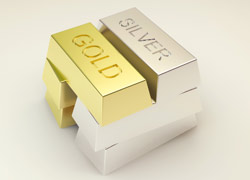The price of different assets is related to each other. Instead of moving in isolation, the markets are intertwined. To make trading decisions, traders can compare the prices of one asset to another when asset prices are correlated. Correlation is the concept behind asset price correlation.
Using a correlation ratio as a trading strategy is the most effective way to make money. The Gold/Silver Ratio is one of the most positively correlated assets in the world.

Gold/Silver Ratio: What Is It?
To calculate the Gold/Silver Ratio, the price of Gold is compared with the price of Silver to determine how many ounces of Silver are needed to acquire one ounce of Gold.
With an increasing Gold/Silver Ratio, Gold becomes more expensive than Silver, and with a decreasing Ratio, Gold becomes less expensive.
Due to their free trade against the US Dollar, Gold and Silver Ratios are free to move around as market forces alter the prices of both commodities.
The ratio of Gold to Silver
Depending on the prices of Gold and Silver, the Gold/Silver Ratio can change.
Gold/Silver Ratio Movements
Gold’s price increasing by a greater percentage than Silver’s increases the Ratio. Ratios increase when Gold’s price decreases by a smaller percentage than Silver’s price.
It increases if the price of Gold rises and the price of Silver declines. A decrease in Gold’s price exceeds a decrease in Silver’s price, reducing the Ratio.
In the case of a smaller increase in Gold’s price than Silver’s price, the Ratio decreases. The Ratio will decrease if the price of Gold decreases and the price of Silver increases.

What factors affect the gold-to-silver ratio?
Changes in the prices of Gold and Silver appear to affect the Gold/Silver Ratio.
Silver’s Effect on the Ratio
There are many industries requiring Silver to produce their products. For example, solar cells and electronics use Silver. This means that its physical demand is an important factor in the global economy. Silver is also traded as a speculative asset.
Gold vs. Silver Value
Due to the market’s size, Silver is about twice as volatile as Gold. A smaller market has less volume to drive prices in either direction, so Silver is more volatile historically.
Silver prices and the demand for its use in manufacturing and industry all contribute to the Gold/Silver Ratio. However, that is only part of the picture.
Gold’s Effect on the Ratio
Gold has no industrial use, so gold is traded mostly as a speculative asset, so gold prices move and affect the Gold/Silver Ratio. It is a haven asset, so investors trade Gold, i.e., turn to Gold to store value during economic turmoil, such as when inflation is high or stocks are down.
The ratio of S&P 500 to gold/Silver
Gold/Silver Ratios are inversely correlated with the S&P 500 Index: when the S&P 500 Index rises, the Ratio typically falls; when the S&P 500 Index falls, the Ratio typically rises.
The Gold/Silver Ratio increased to an all-time high during the stock market downturn in early 2020, which marked the beginning of a bear market for the S&P 500.
Sentiment in the economy
Undoubtedly, economic sentiment plays an important role in driving the Gold/Silver Ratio’s value. Occasionally, traders have even referred to this ratio as a leading economic sentiment indicator.
Conclusion
As the Gold/Silver Ratio varies from rising to falling, it indicates the relative value of Gold for Silver. A rising Ratio indicates Gold’s relative premium over Silver. Because Gold is perceived as a haven asset during troubling economic times, investors consider the Gold/Silver Ratio a sentiment indicator.

